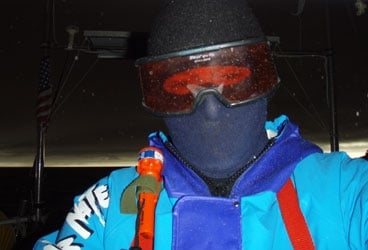
RH Mordor 368
Our passage from Hokkaido to Attu in the outer Aleutian Islands took 14 days. Diana and I were both worn down by gale-force headwinds alternating with calms and concern about our dwindling fuel supply. Once we made landfall, tide rips, confused seas, and contrary winds thwarted our attempts to make way eastward.
As we approached Adak Island, I found the hitherto stout gooseneck shattered, compromising the use of the mainsail. I could feel the concern mounting in Diana so I said cheerfully, “Don’t worry. We still have the Yankee and the engine.”
That night the furling fouled as strong gusts funneled out of Waterfall Bay. The Yankee tore across its leech line. As I tried to tame that mess, Diana quickly fired up the engine, slapped it into gear, and… NOTHING. The brand new transmission was slipping under load.
Under staysail alone, we held station in the narrow entrance to Chapel Cove. I experimented with the transmission and found we could keep it engaged if we kept the rpm just above idle. Not good, but better than nothing. At first light we were able to make our way in to anchor.
For the next three days, as caribou pranced over the mountainous tundra and eagles soared overhead, I cut and drilled thick stainless steel plates to jerry rig a gooseneck while Diana hand stitched the Yankee back into temporary operation.
Diana is not normally superstitious, but she asked me if we were somehow cursed on this voyage. She wanted to stay positive but admitted that she was starting to ask herself, “What next?”
The answer to that question was what the Dutch Harbor newspaper later described as “the unexpected and violent eruption of Mount Kasatochi.”
Unexpected in that the monster had lain dormant for 100 years, waiting for the exact day of our arrival on the island of Kagalaska. Violent in that when it blew it shook the surrounding area with an astounding nine-minute earthquake and blew countless millions of tons of rock, dust, and poison gasses 35,000 feet into the air, blackening the skies into an apocalyptic scene reminiscent of Tolkien’s Mordor.
A passing fishing vessel rescued two terrorized scientists trapped on the island. All air traffic was canceled or re-routed. Warnings were flashed over marine, commercial, and military radio frequencies.
Ignorant of all this, I flopped over to a port tack hoping to weather the jagged point at the entry into Quail Bay. I noticed a strange black cloud begin to shroud the coast. I quietly cursed our bad luck of having a heavy rainsquall render the narrow entrance to Quail Bay even more dangerous.
But Diana grew nervous, saying over and over that it did not look right. She pointed to a yellow haze shimmering before the coming cloud and noted the increasing smell of sulphur. When the grit and ash started to fall, I had to dig out a pair of ski goggles just to see forward.
My mind raced. Is this a major eruption or just downwind spume? Should we tack offshore? If it is cataclysmic, what good would four knots do anyway? Another gale is predicted. Should we seek shelter from the known danger, or flee the vague but potentially far more serious one? Will a tsunami follow?
Day turned to night. I don’t have a lot of experience with the end of the world, but it felt like nothing less. I did not know what to do. When I saw the ominous cloud spread far out over the ocean I decided to try for Quail Bay. Under the lee of a high mountain the visibility improved. We snuck into the very narrow entrance, got an anchor down at the head of the bay, and waited for the event to unfold.
By the time the skies lightened the entire boat was covered in ash. Our new set of sails were completely stained, the Perspex in the dodger scored, the winches and blocks clogged with abrasive dust, and the sheets and halyards caked black. The ash was too thick to sweep off the decks so we had to shovel it. We bucketed countless gallons of seawater over what rigging we could reach and the decks until our backs and arms ached. Two days of hard work had us exhausted but somewhat confident that we were mobile again, unless Kasatochi did an encore.
Of course the emerald tundra we longed to stroll over was now an ashen mess. Clouds of choking dust kicked up as we pushed through the now grey grass, and our clothes were caked in mud. We retreated to the boat.
I had tempered my disappointment at not reaching Kamchatka with the rationalization that that time could be applied to a leisurely frolic through the wilderness of the Aleutians. With the weather delays, breakage, and eruption of Kasatochi, that fantasy has turned to dust, literally.
I love the cruising lifestyle because it is challenging and ever changing. The peaks of experience are high, and the valleys are low. The sail to Dutch Harbor will be uphill.







